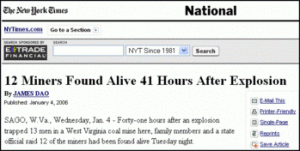41 hours after an explosion in a coal mine in Sago, West Virginia that trapped 13 miners, the nation woke up relieved to see headlines reporting 12 of the 13 miners alive. Headlines in newspapers like USA Today screamed that twelve miners had beaten the odds. However, joy and happiness turned into grief and anger as the truth was later revealed; all but one miner had been rescued and the rest were dead.
It did not take long for news sites to correct the information online, but it was difficult for newspapers that had printed their early editions. Staff at the Newseum reviewed the coverage of the tragedy and found that more than 250 US newspapers published headlines that the miners were alive.
Did reporters get carried away by this bit of good news?
CNN reported that the sign of church bells ringing was the first sign of good news to come and news organizations claimed they based their sources on interviews with Gov. Joe Manchin, who later denied confirming the news, and second-hand accounts of family members. Everyone was ecstatic with this bit of “happy” news and most suspended disbelief.
So why wasn’t the media more skeptical? I mean, could you blame them?
Gov. Manchin and family members seemed like credible sources. The ringing church bells and ambulances reinforced confirmation of the story. In facing a tragedy of 13 dead men, everyone was moved by “a miracle” even though it defied logic.
As the news turned dramatically early in the morning, it caused a lot of confusion, especially for the family members of the miners whom they believed to be alive. A majority of newspapers and wire agencies said that “miscommunication” was the reason for the mix-up. The most likely reason for the misinformation was due to faulty sourcing by reporters who ignored the flaws in the story.
This certainly hurt the credibility of the news media.
The ability to have news 24/7 has brought news coverage to whole new level of immediacy. However, it can also lead to recklessness and irresponsibility by those responsible in reporting accurate information to the public.



Leave a response